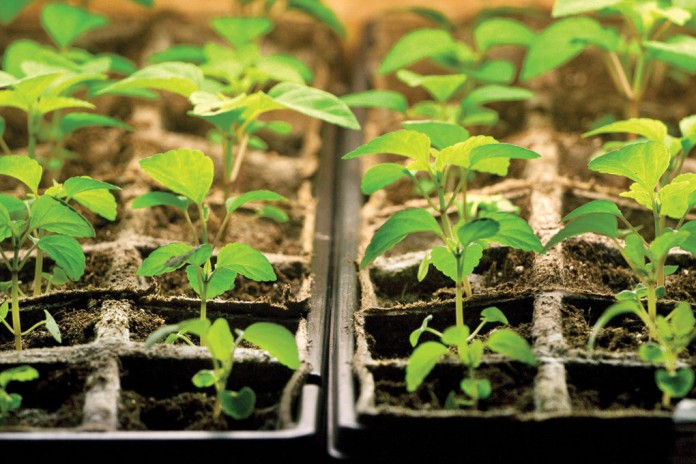Urban farms are filling vacant lots, growing as rooftop gardens, and sprouting in streetside flower boxes. Creative and resourceful city farming methods put-to-use in the country can increase farm yields, productivity and profit.
Urban farming techniques help me optimize space, micromanage renewable resources, and market products direct from Dickie Bird Farm to my customers’ table.
Optimize space
Glistening lines of window hydroponics and gridlocked heads of lettuce grown in square foot gardens- urban farmers operate every inch of city space to its best advantage. By utilizing urban farm space-saving methods outside the city limits, country folks can produce more with less.
A greenhouse takes up a considerable amount of space and can cost several thousand dollars. Heating a greenhouse to keep vegetable seedlings alive on cold winter and early spring nights is an ongoing operating expense. Despite the fact a greenhouse is not economically feasible for country folks like me; I spent several seasons yearning for a greenhouse of my own.
Eventually, I wised up. I utilized an urban model of space optimization to turn the loft of our farmhouse into an indoor greenhouse. As soon as my husband hauls out the Christmas tree, I erect a large PVC pipe grow system upstairs. I line the loft floor with thick black mats that efficiently suck up sunlight and floor heat. Plastic trays and peat containers rest comfortably on top of the mats. T5 lights are suspended from adjustable chains. I lift lighting upward as the seedlings require room to grow. When weather permits I transplant the seedlings outside. I store the grow system until fall, when I use it for season extension.
 My indoor greenhouse cost less than $200; far less than a traditional greenhouse.
My indoor greenhouse cost less than $200; far less than a traditional greenhouse.
Micromanage renewable resources
“Why is there a cement mixer in the corner of your property?” the customer asked a farmhand at a city tree farm and nursery. He chuckled then explained, “It is definitely a mixer, but it makes organic matter, not mortar!” Composting is a superior way that urban farmers make organic matter from free materials like plant material and food scraps.
Urban farmers plant intensively to produce the highest yield possible in limited space. The downside to intensive planting is that it depletes valuable nutrients from the soil. City farmers must micromanage their soil’s heath by constantly adding organic matter to restore nutrients.
Adding manure to compost speeds up decomposition. Poultry manure is the most nitrogen rich manure a farmer can add to compost. City farms that operate under poultry friendly municipal codes often raise a small flock of hens to complement their compost efforts. Urban farms in areas with less farm-friendly laws can achieve the same healthy soil results by vermicomposting with worms.
I use both composting methods at Dickie Bird Farm. Actually, the chickens and red wriggler worms do most of the work for me. In the country, folks can make larger amounts of organic matter and save money on equipment by creating compost in piles instead of city-type tumblers.
Our compost piles are located at the back of our property. I add manure and carbon material to the piles every day. My husband turns the piles with his tractor’s bucket loader to increase oxygen flow within the humus. I apply finished compost before, during and after an intensive growing season.
Direct marketing
Urban farmers often tailor produce and farm products to feed their city’s unique tastes. Growing specialty crops for small ethnic markets or fresh fixings for a local sub shop are innovative and unique ways city farmers move produce. Metropolitan food hubs and downtown farmers markets are additional outlets for farmers to sell directly to urbanites.
Urban farmers favor direct marketing over conventional marketing because it allows them to produce on a smaller scale and keep more of the profit. Consider how direct marketing can work to country folks’ advantage: the average consumer pays $4 for a gallon of milk. The dairy farmer who produced the milk makes less than $1 from the sale. $3 goes to processors, marketers and movers of the milk. If the dairy farmer deletes the middle man, and sells milk shares directly to customers, his profits increase threefold.
Taking products to customers
In 2012 I started a seasonal roadside stand at my farm to market produce and eggs directly to customers. Shoppers can look over the fence and see sweet corn growing. “It doesn’t get any fresher than that!” One customer commented after I sprinted from the field with a crate of turnips to fill her order.
Although I sell directly to customers at the farmer’s market and my roadside farm stand, the roadside stand returns the highest profit per item. Lack of vendor fees and competition allow me to keep roadside prices ultra-low for customers and still make money. At the farmer’s market I must factor competing prices, vendor fees and the county cost of a mobile license into my prices. However, the farmer’s market offers a higher sales volume than the roadside stand. Either way, profit from direct marketing is substantially more than I would make selling through conventional channels.
Learn more
Whether you farm 1/3 an acre, 30 acres or 3000 acres, you can learn valuable urban farming lessons by attending Ohio Master Urban Farmer Workshop Series. The Ohio State University’s seven-part series of urban agriculture classes start the February 5, 2014 in Columbus, Ohio.
The College of Food, Agricultural, and Environmental Sciences urban farming program curriculum offers tips and tools to start or grow a successful and sustainable food business. The information is advantageous for both city and country farmers. Information at http://cfaes.osu.edu/news/articles/urban-agriculture-classes-designed-increase-food-production-enterprises
STAY INFORMED. SIGN UP!
Up-to-date agriculture news in your inbox!











